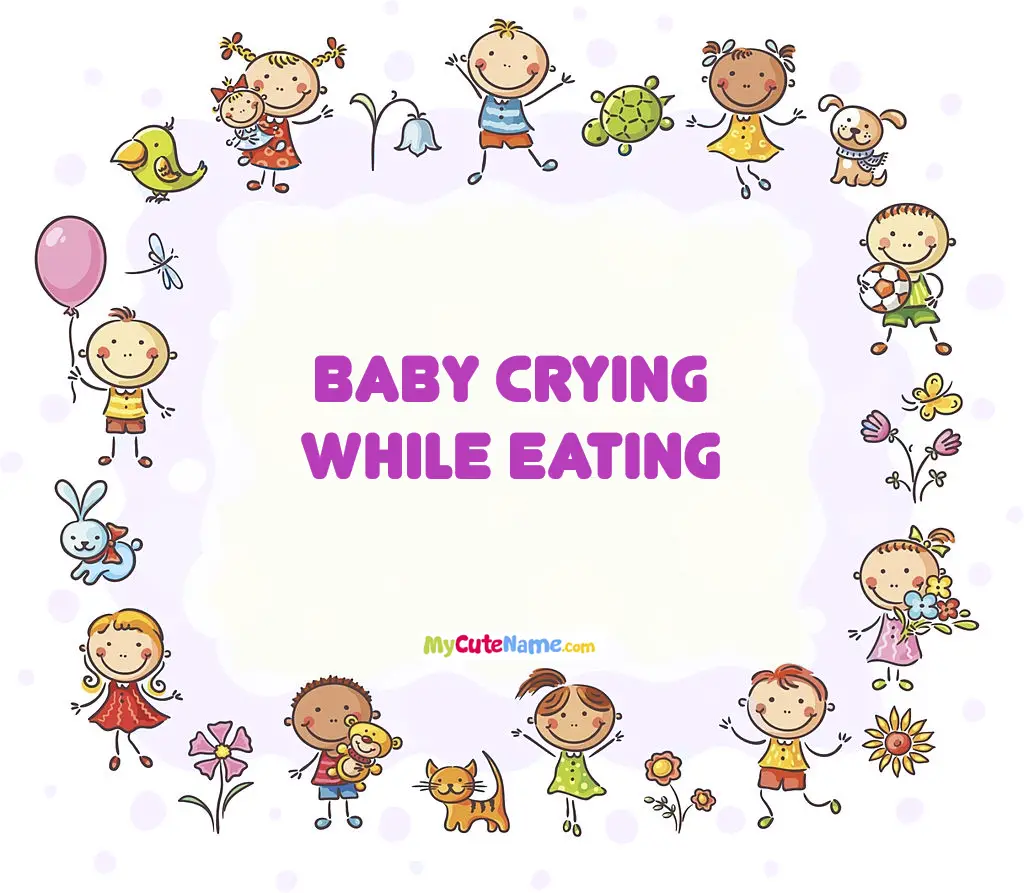


Feeding time is often a cherished bonding moment between a parent and their baby. However, when a baby starts crying during feeding, it can be a source of concern and stress for many parents. Understanding the reasons behind this behavior is essential for addressing the issue effectively. Babies cry while eating for various reasons, ranging from simple hunger to more complex issues like acid reflux or food allergies. This introduction will explore the common causes of crying during feeding, helping parents identify potential problems and find appropriate solutions to ensure a calm and nourishing feeding experience for their little one.
Why Is My Baby Crying While Eating?
Various factors can cause a baby to become fussy during feeding. This doesn't necessarily indicate any fault on your part but suggests that some adjustments might be needed to ensure a smooth feeding experience. Both breastfeeding and bottle feeding present unique challenges, and there are also shared difficulties between the two methods.
Timing
One possible issue is timing. Babies have their own schedules, especially in the early months. Attempting to feed your baby when they're already full can lead to fussiness and refusal to eat. Conversely, if you wait too long to feed them, they might become overly hungry and too distressed to latch or eat properly.
Mood
Occasionally, your baby might not be in the right mood for eating. If they are overtired, it can make feeding much more challenging for them.
Gastric Discomfort
Your baby might simply need to be burped. If they swallow air while feeding, it can cause gas in their stomach that needs to be released. Additionally, reflux, where food comes back up from the stomach, can also cause fussiness, though it is less common in infants.
Growth Spurts and Physical Conditions
Your baby might simply need to be burped. If they swallow air while feeding, it can cause gas in their stomach that needs to be released. Additionally, reflux, where food comes back up from the stomach, can also cause fussiness, though it is less common in infants.
Why Do Babies Cry While Breastfeeding?
If you're determined to breastfeed but your baby fusses every time you try, it can be disheartening. However, there are several strategies you can employ to facilitate successful breastfeeding once you identify the root cause of the problem. One common issue faced by breastfeeding mothers and babies is improper latching. Without a proper latch, babies struggle to extract milk effectively, leading to fussiness. This may stem from lack of experience or could be due to fatigue or distress. Additionally, physical conditions like tongue-tie or cleft lip/palate can hinder proper latching and sucking. Another reason for fussiness during breastfeeding could be an overactive let-down, where milk is released too quickly due to overly full breasts. Conversely, a slow let-down might also cause frustration for babies who don't want to wait for milk. Breast milk can also take on the flavors of the foods consumed by the mother, including spicy foods. If you've eaten something spicy and notice your baby fussing during nursing, it could be due to the spiciness of your breast milk. However, avoiding spicy foods isn't necessarily required, as some babies may actually prefer milk with diverse flavors.
Why Do Babies Cry While Bottle Feeding?
Parents who opt for bottle feeding may encounter various challenges depending on the type of milk they use—whether it's breast milk, formula, or a combination of both. One common issue could be the suitability of the bottle itself for your baby's needs. It's possible that the bottle may dispense milk too quickly or be difficult for your baby to feed from, resulting in dissatisfaction. Additionally, finding the right formula can be a process of trial and error. Some babies may react poorly to certain formulas, experiencing issues like reflux, gas, or general discomfort. Temperature also plays a crucial role—formula that is too hot can scald your baby, while formula that is too cold may be unpalatable. Moreover, if your baby has lactose intolerance, formulas with a cow milk base may not be suitable, and opting for a hypoallergenic formula could be beneficial.
What Should I Do To Help?
Supporting your baby in having a satisfying feeding experience, whether through nursing or bottle-feeding, may require some experimentation and patience. Here are some practical suggestions to help your baby feed contentedly and minimize fussiness:
Firstly, tune into your baby's cues. Signs like rooting, sucking on hands, or sticking out their tongue indicate hunger, but it's best to feed them before they become overly hungry and fussy.
If your baby is already crying due to hunger or fatigue, soothe them before attempting to feed. Stay calm, and don't hesitate to ask for assistance from a family member or caregiver when needed.
After calming your baby, proceed with feeding. Burping your baby during and after feeds can help release any trapped gas in their stomach, aiding digestion.
A quiet and peaceful environment can facilitate feeding, as distractions can disrupt your baby's focus.
When your baby indicates they're done feeding by turning away from the bottle or breast, respect their cues and refrain from offering more food.
Temporary fussiness during growth spurts is normal and should subside with time, provided you respond to your baby's cues appropriately.
For sick or teething babies, continue offering feeds as usual. To ease congestion from a stuffy nose, consider using a nasal aspirator to clear their airways. For teething discomfort, offer a chilled teething toy, gently massage their gums, or consult your pediatrician for suitable pain relief options.
How To Help Breastfeeding Babies
Consult with a Lactation Specialist
When struggling with latching issues, seeking guidance from a lactation consultant can be invaluable. These experts can provide tailored advice and techniques to improve your baby's latch and breastfeeding experience.
Embrace Skin-to-Skin Contact
Skin-to-skin contact fosters bonding and can enhance your baby's ability to latch effectively. Utilizing a Tabeeze Bottom-Up Baby Bodysuit simplifies skin-to-skin time, allowing easy access for nursing while keeping your baby comfortably dressed.
Experiment with Positions
Exploring different breastfeeding positions and alternating sides can alleviate difficulties your baby may encounter. Some infants may have a preference for a particular breast, leading to fussiness if not accommodated.
Opt for Morning Feedings
Feeding your baby upon waking, when they are content and alert, can facilitate smoother latching and feeding sessions. Babies tend to be more cooperative and less fatigued during this time.
Manage Milk Flow
If faced with an overactive let-down, expressing or pumping a small amount of milk before nursing can regulate the flow, preventing overwhelming milk flow. Similarly, expressing milk can stimulate milk flow for babies experiencing slow let-down, ensuring they receive adequate nourishment. Offering a bit of expressed milk on the nipple can also encourage latching in some cases.
Assisting Bottle-Feeding Babies
Adjust the Bottle Nipple
For bottle-fed infants, selecting an appropriate bottle nipple is crucial. If the flow is too fast or too slow, trying different nipple types may alleviate feeding difficulties.
Consider Formula Alternatives
Exploring different formula options can address feeding challenges. Consulting your baby's pediatrician can provide insights into formula types that may better suit your infant's needs.
Tracking your baby's feeding schedule and observing their reactions can help identify patterns and preferences. For instance, sensitivity to lactose-based formulas may manifest as hives in some babies.
Space Out Feeding Times
Managing reflux may involve spacing out feeding sessions. Rather than offering large volumes of formula at once, feeding smaller amounts at more frequent intervals can mitigate reflux symptoms. Avoid overfeeding, as excessive intake may exacerbate spit-up episodes.
Monitor Formula Temperature
Ensuring the formula is at an appropriate temperature is essential for your baby's comfort. Test the formula temperature by shaking a droplet on the inside of your wrist. If it feels excessively hot, allow it to cool to a suitable temperature before feeding your baby.
Conclusion
In conclusion, babies crying during feeding can be distressing for both parents and infants, but it's important to remember that it's a common occurrence and often has simple solutions. By paying attention to cues, addressing potential issues such as latching difficulties or formula concerns, and providing a calm and supportive environment, parents can help alleviate feeding-related fussiness. Consulting healthcare professionals for guidance and remaining patient throughout the process can contribute to a more positive feeding experience for both parent and child.
Note: Please also check your spam or junk email folder.